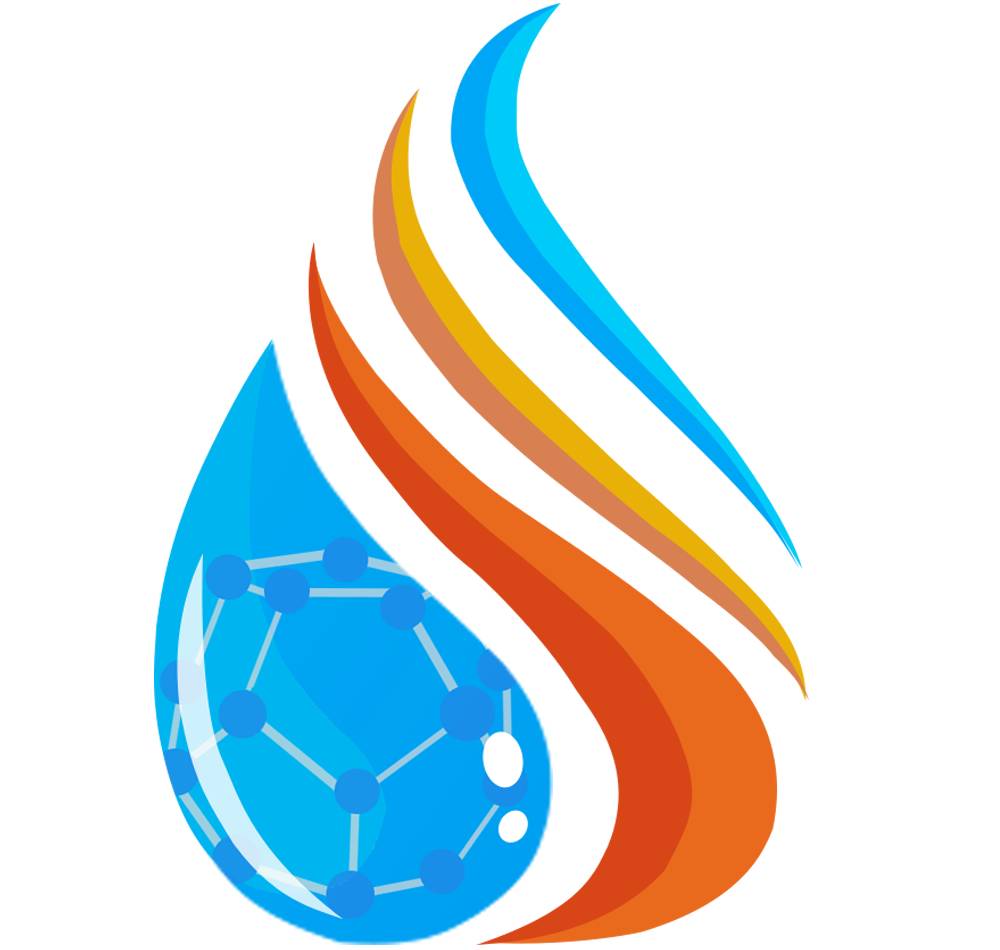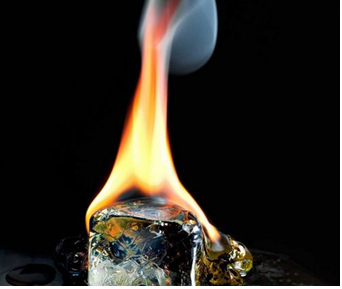《佳文速递》2025年第7期
 收藏
收藏
Viable hydrate-based CO2 capture facilitated by cyclopentane hydrate seeds and tailored kinetic promoters
环戊烷水合物种子和定制的动力学促进剂可促进可行的水合物二氧化碳捕获
发表时间:2025年7月9日
发表期刊:《Chemical Engineering Journal》
Wonhyeong Lee, Kwangbum Kim, Jeongwoo Lee, Dong Woo Kang, Yun-Ho Ahn, Seungin Lee, Youngjune Park, Jae W. Lee
Abstract: With the increasing demand for scalable carbon capture technologies, environmentally benign clathrate hydrate-based systems have gained attention. However, unpredictable nucleation delays, slow hydrate formation kinetics, and reliance on energy intensive agitation methods have impeded industrial adoption of CO2 hydrates. This study reports significantly high CO2 uptakes of 0.1503mol CO2/mol H2O for structure I (sI) CO2 hydrates and 0.0693mol CO2/mol H2O for structure II (sII) cyclopentane (CP)-CO2 hydrates under static conditions. Critically, the introduction of hydrate seeds and specifically tailored kinetic promoters lead to instantaneous nucleation, an occurrence not previously reported. Our findings, supported by kinetic analyses and molecular dynamics simulations, reveal that sodium alkyl sulfate, which is effective in various hydrate systems including natural gas storage, inhibited sI CO2 hydrate formation under static conditions due to interference by its long alkyl chains with CO2 interactions. In contrast, moderate hydrophobic amino acids, particularly L-methionine, significantly enhanced hydrate formation kinetics through optimal interactions with CO2molecules. Ex-situ and in-situ Raman spectroscopy confirmed that in sII CP-CO2 systems, the use of L-methionine resulted in high CO2 uptake due to co-enclathration of CO2 and CP molecules, whereas the surfactant molecules reduced CO2 storage capacity by promoting rapid CP hydrate growth. These results offer critical guidelines for promoter selection and significantly advance the industrial viability of hydrate-based CO2 capture technologies.
Keywords: Clathrate hydrates; Carbon capture; CO2 hydrates; Kinetic hydrate promoter; Inclusion compounds
Fig.3 (a) Evolution of the potential energy for hydrate formation systems with various combinations of gas and kinetic promoter molecules. (b) Example of the initial configuration used in the bulk solution simulations, illustrated for the CO2/SDS system. Component representations are consistent with those in Fig.2. (c) Lennard-Jones potential energy calculated from bulk solution simulations for different combinations of gas molecules and kinetic promoters. (d) Radial distribution functions between the centers of mass of kinetic promoters and gas molecules obtained from bulk solution simulations.
https://doi.org/10.1016/j.cej.2025.165846.
Enhancing real-time gas production from muddy methane hydrate reservoirs: The impact of optimal production pressure
提高泥质甲烷水合物储层的实时产气量:最佳生产压力的影响
发表时间:2025年7月7日
发表期刊:《Energy》
Guangjun Gong, Mingjun Yang, Qianyong Liang, Chenlu Xu, Yongchen Song
Abstract: The dynamic optimization of the depressurization strategy, especially production pressure, is very important to improve the exploitation efficiency of methane hydrate reservoirs for enhancing gas recovery. Previous studies lack specific conclusions on quantifying the optimal adjustment and multi-parameter sensitivity analysis of production pressure in hydrate reservoirs. Therefore, 10 hydrate cores with hydrate saturations (28.9%~44.6%) using South China Sea soil within a core holder are remolded. The results show that there is an optimal production pressure during depressurization, which yields the maximum production rate. Compared to other gas production pressures (0~7MPa), the gas flow rate is increased by 0.015ml/s at the optimal gas production pressure, which is an increase of almost 59%. Meanwhile, combined with the permeability equation, gas production flow curves with correlation coefficients distribution between 0.91 and 0.97 are proposed. The logical reasoning and calculation formulae for the optimal gas production pressure under different in situ conditions are given. Finally, combined with an orthogonal experimental design, absolute permeability, and gas source pressure are prioritized parameters for obtaining maximum production rate and optimal production pressure, respectively. This study provides important theoretical guidance for dynamically optimizing the gas production pressure to improve the gas production efficiency.
Keywords: Methane hydrate; Depressurization strategy; Muddy reservoir; Optimal production pressure; Sensitivity analysis
Fig. 2. Schematic diagram of the experimental apparatus.
https://doi.org/10.1016/j.energy.2025.137401
Coupling depressurization and flue gas flooding to enhance CH4 recovery and CO2 sequestration in hydrate-bearing sediments: Pilot-scale experimental evaluation at marine conditions
将减压和烟气淹没结合起来,提高含水合物沉积物中的甲烷回收和二氧化碳封存:海洋条件下的中试规模实验评估
发表时间:2025年6月28日
发表期刊:《Energy》
Yuanxin Yao, Mengya Niu, Mucong Zi, Yi-Fei Sun, Daoyi Chen
Abstract: The industrialization of natural gas hydrate (NGH) extraction faces significant challenges due to low gas production capacity, necessitating new methods to improve. This study investigates the CH4 recovery from water-saturated pilot-scale hydrate-bearing sediments (HBS, V=22L) via coupling depressurization with semi-continuous flue gas flooding. Key factors, including the timing, rate, and composition of flue gas injection, were analyzed for their effects on CH4 recovery, NGH dissociation, and CO2 storage. Injecting flue gas (CO2/N2=15/85) after 60% NGH dissociation during depressurization yielded the optimal performance, increasing CH4 recovery ratio from 70.8% to 86.4%, boosting recovery and NGH dissociation rates by 36.4% and 25.5%, respectively. Lower injection rate delayed gas breakthrough, improving CH4 recovery. Water-alternating-gas injection, however, lowered the produced gas-to-water ratio and resulting CH4 recovery efficiency. Following CH4 extraction, CO2-rich flue gas injection induced CH4/CO2/N2 hydrate (Mix-H) formed and gradually grew toward the production well. Gas composition in depleted HBS influenced Mix-H kinetics more than residual gas saturation. The maximum CO2 storage ratio in hydrates reached 30.1%, with a hydrate restoration ratio of 28.7% for HBS. The total stored CO2 provides a carbon offset of up to 99.4% for CH4 production, demonstrating the potential for carbon-neutral NGH extraction.
Keywords: Natural gas hydrate; Flue gas flooding; Depressurization; Enhanced gas recovery; CO2 sequestration; Mixed hydrate
Fig. 3. Schematic diagram of the consecutive experimental processes of CH4 recovery by depressurization and flue gas flooding, and CO2 storage by CO2/ N2 injection.
https://doi.org/10.1016/j.energy.2025.137328
CO2-hydrate crystal phase distribution and morphology in saline solutions: Optical and micro-Raman analysis within high pressure micro-capillaries
盐溶液中的CO2-水合物晶相分布和形态:高压微毛细管中的光学和微拉曼分析
发表时间:2025年6月20日
发表期刊:《Journal of Environmental Chemical Engineering》
Sadain Zafar, Rima Haidar, Claire Pirim, Bertrand Chazallon
Abstract: The formation of CO2 hydrates in 3.5wt% NaCl solutions is investigated using optical and micro-Raman spectroscopy in newly developed micro-capillary high-pressure reactors. This study offers detailed insights into micron-scale hydrate morphology and phase distribution, relevant for combined desalination and carbon capture. The influence of initial CO2 saturation—partial (CO2-UnS) vs. full (CO2-S)—was examined. Primary hydrate nucleation occurred at 246K under isobaric cooling, with hydrate spatial distribution strongly dependent on gas saturation. In CO2-S systems, hydrates displayed a granular texture throughout the capillary, while in CO2-UnS, they remained near the meniscus. Secondary hydrate formation was induced via annealing (up to 275K) followed by cooling to 263K. Raman and optical analyses revealed a homogeneous hydrate distribution in CO2-S, whereas CO2-UnS showed significant phase heterogeneity, including gas, liquid, dissolved CO2, hydrate slurry, and isolated single-crystal hydrates. Mass transfer limitations were observed in CO2-UnS due to polycrystalline deposits obstructing the liquid/gas interface. In contrast, CO2-S systems exhibited widespread hydrate formation, suggesting direct hydrate nucleation in the liquid phase. In both systems, a thin hydrate film formed on the capillary wall on the gas side of the meniscus, likely reflecting surface interactions that affect mass transfer. This combined microscopic approach provides novel insights into hydrate crystal growth in saline solutions and underscores the crucial influence of initial CO2 saturation on hydrate behavior, with implications for advancing hydrate-based desalination and carbon capture technologies.
Keywords: Desalination; CO2 capture; Gas hydrates; Spectroscopy; Microscopy; Micro-capillaries
Fig.1. A schematic illustration of high-pressure capillary cell coupled with the micro-Raman spectroscope.
https://doi.org/10.1016/j.jece.2025.117680.
Nanostructured encapsulation for controlled CO2 storage as clathrate hydrate in sub-seabed saline sediments: Containment, stability, and field scale application toward decarbonization. A review
用于在海底盐沉积物中以凝块水合物形式受控封存二氧化碳的纳米结构封装: 封存、稳定性和在脱碳领域的实地应用综述
发表时间:2025年6月26日
发表期刊:《Journal of Environmental Chemical Engineering》
Erasto E. Kasala, Jinjie Wang, Wakeel Hussain
Abstract: Carbon dioxide (CO2) sequestration via clathrate hydrate formation in sub-seabed saline sediments offers a promising solution for reducing anthropogenic CO2 emissions. Nanostructured encapsulation using nanomaterials, such as carbon nanotubes, metal-organic frameworks (MOFs), graphene oxide, and bio-inspired designs has shown potential in stabilizing CO2 within solid matrices, enabling controlled hydrate formation and storage. However, fluctuating pressure, temperature, and salinity conditions, especially in harsh environments, challenge encapsulation stability, requiring material optimization for sediment compatibility. Nanomaterials additives enhance hydrate stability, CO2 absorption efficiency, and mass transfer, though the performance depends on type, size, texture, composition, and formation conditions. Synergistic effects between nanomaterials and surfactants/polymers further improve interfacial tension (IFT) reduction, induction time, and storage capacity. This work highlights key mechanisms governing nanomaterials' CO2uptake in subseafloor sediments, including adsorption/absorption, diffusion, structural modifications, confinement effects, and hydrophobic interactions. In addition, the study underscores advanced characterization techniques, such as Raman spectroscopy, XRD, and molecular dynamics, providing insights into structural and thermal properties, while field studies in regions like the North Sea and Norway highlight practical challenges. Despite progress, scalability, cost-effectiveness, and environmental safety under variable subsea conditions remain hurdles. Emerging innovations, such as stimuli-responsive nanomaterials and hierarchical encapsulation architectures, could optimize long-term CO2 storage and controlled release. By integrating the collective findings drawn from both empirical data in published papers and theoretical deductions, this work provides a roadmap to enhance comprehension regarding the screening, design, formation, nucleation, and growth of CO2 hydrate in nanostructured encapsulation system toward sustainable CO2 storage and global decarbonization goals.
Keywords: CO2 hydrate storage; Nanomaterials; Stability; Gas-liquid interface
Fig. 16. Schematic representation of CD inclusion complex sedimentation within the encapsulation system, indicating a reduction in gas adsorption in DW or DCD. (a) The initial phase, (b) Hydrate and CD inclusion complex formation, and (c) Blockage due to CD inclusion sedimentation
https://doi.org/10.1016/j.jece.2025.117765.
Purification of low concentration coalbed methane via hydrate formation enhanced by carbon-based nanopromoters
通过碳基纳米促进剂强化水合物形成提纯低浓度煤层气
发表时间:2025年6月26日
发表期刊:《Fuel》
Yongtao Zhang, Zaizheng Jiang, Zhiliang Tu, Zhihe Xin, Fei Wang
Abstract: Hydrate technology is a promising method for the separation and purification of low concentration coalbed methane (LCCBM). However, the separation efficiency and methane (CH4) recovery rate using the hydrate method are relatively low, which limits its practical application in production. Therefore, this study prepared two highly efficient promoters to enhance hydration and recover CH4 from LCCBM. The −SO3− group, which is similar to the hydrophilic group of sodium dodecyl sulfate (SDS), was fixed on the surface of the graphene oxide layers (named −SO3−@GO), and the surface of carbon nanotubes was coated with the macromolecular chain PSCS containing the −SO3− group (named PSCS@CNTs). The experimental results showed that in the presence of tetrahydrofuran (THF), the hydration enhancement and CH4 recovery effects of −SO3−@GO and PSCS@CNTs were concentration dependent. When −SO3−@GO concentration was optimal at 0.75g/L, the CH4 recovery and separation factor were 54.47% and 3.91, respectively. When PSCS@CNTs concentration was optimal at 0.15g/L, the CH4 recovery and separation factor were 57.30% and 4.23, respectively. Meanwhile, −SO3−@GO and PSCS@CNTs have good cycling performance. After 6 repeated experiments, the CH4 recovery rate and separation factor of −SO3−@GO were only reduced by 4.99% and 2.41%, respectively. The CH4 recovery of PSCS@CNTs was only reduced by 5.08%, and the separation factor was almost unchanged. The−SO3−@GO and PSCS@CNTs developed in this study exhibit high CH4 recovery rate, high CH4enhancement and good cycling performance, which have great potential in LCCBM recovery.
Keywords: Hydrate; Low concentration coalbed methane; Nanopromoters; Recovery
Fig. 2. Schematic diagram of the preparation PSCS@CNTs process.
https://doi.org/10.1016/j.fuel.2025.136075.
 UPC-WY
UPC-WY

 DWOG-Hyd 2021
67帖子
DWOG-Hyd 2021
67帖子
 Haotian Wang
9帖子
Haotian Wang
9帖子
